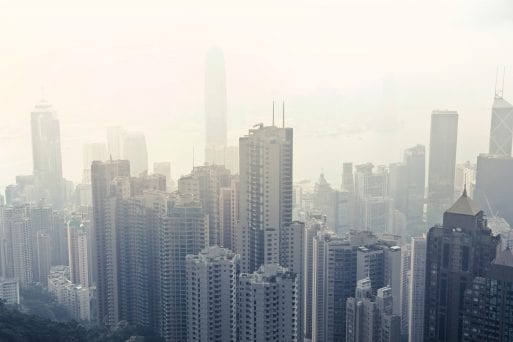
A night view of Hong Kong, blanketed in smog.
Studies from around the globe are linking air pollution to a greater likelihood of death from COVID-19. Researchers at Harvard University found that U.S. counties with more air pollution have experienced significantly higher death rates. An analysis published in the journal “Environmental Pollution” found that two heavily polluted regions of northern Italy experienced a death rate nearly three times higher than the rest of the country. And a study of 66 administrative regions in Italy, Spain, France and Germany determined that 78 percent of COVID-19 deaths took place in the five that were most polluted.
Air pollution has long been recognized as a leading cause of mortality. The World Health Organization has estimated that air pollution kills some 7 million people per year, prompting director-general Tedros Adhanom Ghebreyesus to label it a “public health emergency.” Meanwhile, a 2019 global review found that air pollution affects nearly every organ in the body, causing heart disease, bladder cancer, diabetes, fertility problems, dementia and a wide range of other ailments.
Because air pollution severely damages the lungs, it’s not surprising that long-term exposure would heighten the impact of COVID-19, a disease that can cause fatal respiratory symptoms. “Previous work showed that air pollution exposure dramatically increased the risk of death from SARS during the 2003 outbreak,” Rachel Nethery, a researcher on the Harvard study, told The Guardian. “So we think our results here are consistent with those findings.”
Fine Particulate Matter Causes Health Issues
Harvard’s nationwide, cross-sectional study drew on COVID-19 death counts from more than 3,000 U.S. counties up until April 22, adjusted for poverty levels, stay-at-home orders, obesity and other factors. It found that just a small increase in fine particulate matter — the minuscule particles that can make cityscapes appear hazy — increased the likelihood of death by 8 percent.

Credit: Andrea Piacquadio
Fine particulate matter, also known as PM2.5, comes from wildfires, coal-fired power plants, diesel engines and other sources. A recent report from the American Lung Association found that U.S. cities are experiencing more spikes in particle pollution, and nearly half of the nation’s population breathes polluted air. One study, yet to be peer-reviewed, has suggested that the virus can actually reside on, and be spread by, particulate matter.
An unintended benefit of lockdowns around the world has been a significant reduction in particulate matter. A recent report from Swiss air quality company IQAir, released on Earth Day, found that 10 major cities around the world with lockdowns — including New Delhi, Seoul and Wuhan — have seen significant improvements in air quality. Images of the Himalayas, visible for the first time in decades for many in northern India, as well as dramatic before-and-after shots of cities including Los Angeles, Jakarta, New York and Milan, have been widely shared on social media.

A monk views the Annapurna mountains in the Himalayas of Nepal.
Importance of Reducing Air Pollution
Yet, experts warn that lifting lockdowns too early, and thus increasing pollution, could contribute to a spike in COVID-19 deaths. “We urgently need more studies, since locally generated particle pollution will bounce back once the lockdown is eased,” Jonathan Grigg, a professor of pediatric respiratory and environmental medicine at Queen Mary University of London, told The Guardian.
Meanwhile, the U.S. Environmental Protection Agency has issued a temporary policy suspending enforcement of pollution controls during the pandemic — a fact noted by researchers at Harvard. “Our results underscore the importance of continuing to enforce existing air pollution regulations to protect human health both during and after the COVID-19 crisis,” the Harvard study read.

 Air Pollution Tied to Higher COVID-19 Death Rates
Air Pollution Tied to Higher COVID-19 Death Rates


 Our Annual Seven Holiday Gifts for Someone Who Is Grieving, 2024 Edition
Our Annual Seven Holiday Gifts for Someone Who Is Grieving, 2024 Edition
 “Making Mobiles” by Karolina Merska
“Making Mobiles” by Karolina Merska
 “Hands Up to the Sky” by Michael Franti & Spearhead
“Hands Up to the Sky” by Michael Franti & Spearhead














